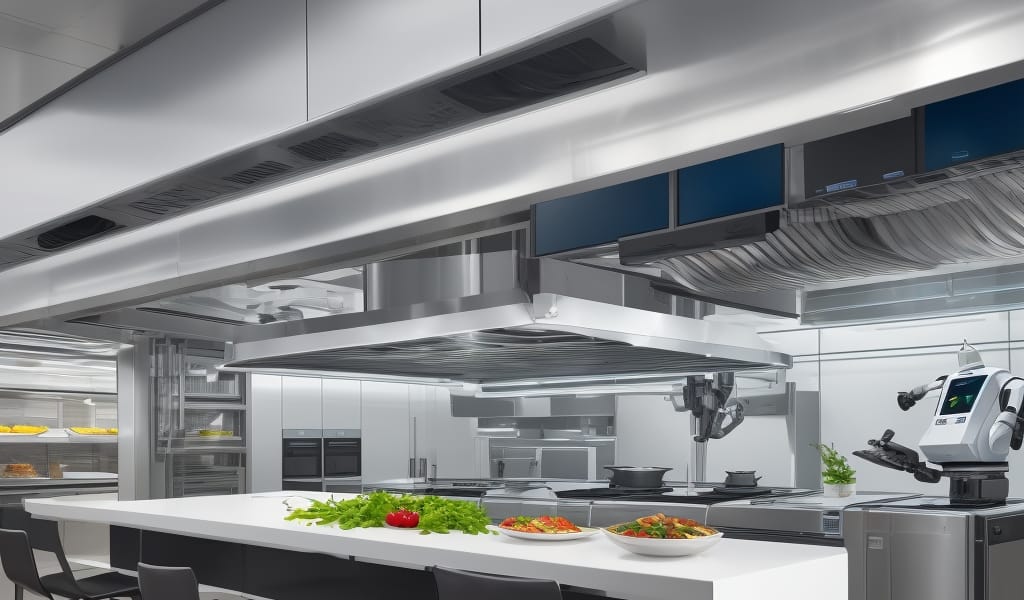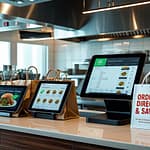Key Takeaways:
- Implement AI in your kitchen to streamline operations and increase efficiency.
- Use restaurant automation tools for tasks such as prepping ingredients, cooking, and cleaning to save time.
- Adopt smart cooking technology to ensure consistent food quality and reduce waste.
- Leverage AI to personalize customer dining experiences, enhancing customer satisfaction and loyalty.
- Regularly update and monitor your AI kitchen tools to ensure optimal performance and return on investment.
AI in the Kitchen: How It’s Actually Being Used
Real-world uses of AI in modern kitchens
The culinary world is undergoing a radical transformation, driven by the integration of artificial intelligence (AI) into kitchen operations. No longer confined to futuristic fantasies, AI technologies are reshaping the way restaurants operate, streamlining processes, and enhancing guest experiences. From robotic cooking assistants to predictive inventory management, artificial intelligence is quickly becoming a crucial tool in modern kitchen management.
But what does AI look like in practical terms, and how can restaurant owners and managers realistically leverage it to their advantage? In this article, we’ll explore real-world examples and actionable insights into how AI is actively reshaping restaurant kitchens today.
Automated Cooking and Food Preparation
Robotic Chefs and Automated Equipment
One of the most visible applications of AI in the kitchen is the rise of robotic chefs. These robots use advanced AI algorithms to replicate human cooking techniques with precision and consistency, helping restaurants maintain quality standards and efficiency.
For instance, Moley Robotics has developed a fully automated kitchen that can prepare complex dishes from scratch, following precise recipes programmed into its AI-driven software. The robotic arms mimic professional chef movements, allowing for consistent quality and reduced labor costs.
Benefits for Restaurant Owners
- Consistent food quality and presentation
- Reduced labor costs and staffing issues
- Increased operational efficiency and faster service times
By adopting robotic cooking technologies, restaurant owners can significantly reduce human error and improve overall kitchen productivity.
AI-Powered Inventory and Supply Chain Management
Predictive Inventory Tracking
Managing inventory efficiently can be a challenging and time-consuming task. AI-based systems can predict inventory needs using historical data, current trends, and real-time sales data, ensuring optimal supply levels and reducing waste.
AI-driven inventory platforms such as CrunchTime leverage machine learning algorithms to anticipate demand fluctuations. This allows restaurant managers to make informed purchasing decisions, reducing food spoilage and minimizing inventory expenses.
Actionable Advice for Implementing AI Inventory Management
- Choose an AI inventory management tool tailored to restaurant operations
- Integrate your POS system with inventory software for real-time insights
- Regularly analyze reports to identify patterns and improve forecasting accuracy
Enhanced Food Safety and Quality Assurance
AI-Driven Safety Monitoring
Food safety is paramount in the restaurant industry. AI technologies enhance monitoring and compliance by automating inspections and analyzing real-time data from kitchen operations.
For example, AI-powered sensors can continuously monitor refrigeration temperatures, alerting staff immediately if hazardous conditions occur. Platforms like SmartSense use AI algorithms to help restaurants comply with food safety regulations, reducing the risk of contamination and costly health violations.
Practical Steps for Integrating AI Safety Systems
- Identify critical points in your kitchen that require monitoring (e.g., refrigeration units, cooking stations)
- Select AI-enabled monitoring tools to automate temperature and hygiene checks
- Train staff to respond quickly to alerts generated by AI systems
Personalized Customer Experiences with Smart Cooking
AI-Based Menu Customization
Personalized dining experiences are becoming increasingly popular. AI enables restaurants to provide tailored menu suggestions based on customer preferences, dietary restrictions, and previous orders.
Restaurants like McDonald’s have adopted AI-driven menu personalization in their drive-thru services, dynamically suggesting menu items based on time of day, weather conditions, or popular choices. This customization enhances customer satisfaction and boosts average order value.
Tips for Implementing AI-Driven Personalization
- Integrate AI recommendation systems with your digital ordering platforms
- Analyze customer data regularly to refine and improve menu suggestions
- Offer personalized promotions to increase guest engagement and loyalty
AI-Enhanced Staff Scheduling and Management
Optimizing Labor Costs and Productivity
Staff scheduling can often be a headache for restaurant managers. AI-supported scheduling solutions analyze multiple factors, including customer traffic patterns, labor costs, and employee availability, to create optimal schedules.
Platforms like Deputy and 7shifts utilize AI-driven insights to streamline scheduling, reduce overtime expenses, and improve overall staff management. Restaurants can proactively adjust staffing levels, ensuring smooth operations during peak hours and reducing unnecessary labor costs during slower periods.
Best Practices for Using AI Scheduling Tools
- Select a scheduling platform suited to your restaurant size and operational requirements
- Integrate your scheduling software with POS and inventory systems for comprehensive insights
- Regularly review staffing reports to fine-tune labor management strategies
Real-World Examples of AI Integration in Restaurants
Spyce Restaurant: The Fully Robotic Kitchen
Spyce, a Boston-based restaurant, has made headlines with its fully robotic kitchen. Developed by MIT graduates, Spyce utilizes robotics and AI to manage food preparation, maintain consistency, and ensure quality control. This innovative approach significantly reduces labor costs and enhances operational efficiency.
Domino’s Pizza: AI-Powered Delivery and Order Tracking
Domino’s Pizza has successfully integrated AI into delivery tracking and order management. Their AI-driven systems predict order preparation times, optimize delivery routes, and provide real-time updates to customers, enhancing customer satisfaction and operational efficiency.
Conclusion
The integration of AI in kitchen operations is no longer a trend reserved for tech-savvy innovators—it’s rapidly becoming a necessity for restaurants aiming for operational excellence. From automated cooking and predictive inventory management to personalized guest experiences and enhanced staff scheduling, AI offers practical solutions for the most pressing challenges restaurants face today.
Restaurant owners and managers who embrace AI technologies will be better positioned to streamline operations, reduce costs, and deliver exceptional customer experiences. By understanding and leveraging the real-world applications highlighted here, restaurants can stay competitive and thrive in the ever-evolving industry landscape.






Comments
Be the first to comment on this article.